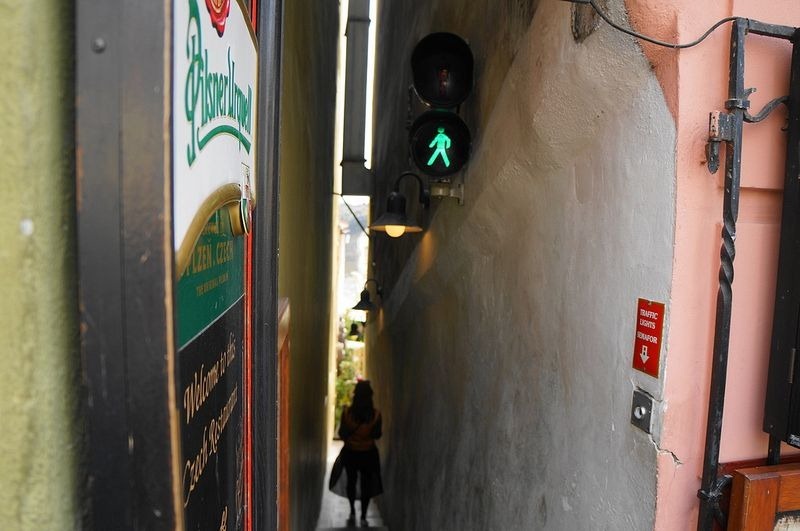The street is part of the oldest neighborhood in Prague, the historic Mala Strana (“Little Quarter”), close to the Charles Bridge. It is so narrow that is literary impossible for two people to pass at the same time. The name of the street is “Vinarna Certovka” and it is 10 meters long with the passage 50 centimeters wide. It has several stone steps, leading from “U Luzickeho” seminar street to the Certovka restaurant on the edge of Certovka canal.
This tiny street is so narrow, that they equipped it with traffic lights so people wouldn’t collide. But actually the light are more of an attraction for tourists. People come, push the button, go to the other side of the street, take a few pictures and go back. They usually don’t take the traffic lights seriously and end up colliding with someone coming from the other side.
The owner of the restaurant at the end of the street remembers a story about somebody getting stuck: “One time, one really corpulent German tourist got stuck. She couldn’t go up or down. The personnel tried to push her back to the street, but in vain. In the end we had to soap her, so she would slide more easily. She just had to go somewhere else for her lunch.”
The quarter of Malá Strana (“Little Quarter”) or officially called Menší Město pražské (Lesser Town of Prague) is a district of the city of Prague, Czech Republic, and one of its most historic regions. Malá Strana was founded by the King Ottokar II of Bohemia in 1257. As a royal town (a town founded by the king), it got many privileges. It was created by amalgamating a number of settlements beneath the Prague Castle into a single administrative unit. The original residents were expelled and mostly German craftsmen and merchants were invited by the king. Even though the city was royal, the king did not master the city as a whole.
In the Middle Ages, it was a dominant center of the ethnic German (and since 16th century also Italian) citizens of Prague. It also housed a large number of noble palaces while the right-bank towns were comparatively more bourgeois and more Bohemian Czech.
Baroque architecture predominates in Malá Strana, but the history of the district dates back to far before the Baroque era. Baroque architecture eventually dominated when the style became successfully implanted on Malá Strana after the district was devastated by fires in 1541.
The most extensive and unforgettable building of the Baroque Era on Malá Strana is the Wallenstein Palace. Albrecht von Wallenstein was a military general-in-chief of Emperor Ferdinand II. Under his order, 26 new houses and old gates were built on the freed place. The extensive palace complex with five courtyards and the garden, which is set as a French Park.
The churches are the most frequent and interesting developments on Malá Strana. The finest one and the most prominent is the St. Nicholas Church. The famous statue of the Holy Infant Jesus of Prague is in the Church of Our Lady Victorious in Malá Strana.
Source: amusingplanet, ru-travel.

![vinarna-certovka-2[6]](https://www.thevintagenews.com/wp-content/uploads/sites/65/2015/11/vinarna-certovka-26.jpg)
![vinarna-certovka-3[2]](https://www.thevintagenews.com/wp-content/uploads/sites/65/2015/11/vinarna-certovka-32.jpg)
![vinarna-certovka-4[2]](https://www.thevintagenews.com/wp-content/uploads/sites/65/2015/11/vinarna-certovka-42.jpg)
![vinarna-certovka-6[2]](https://www.thevintagenews.com/wp-content/uploads/sites/65/2015/11/vinarna-certovka-62.jpg)
![vinarna-certovka-8[3]](https://www.thevintagenews.com/wp-content/uploads/sites/65/2015/11/vinarna-certovka-83.jpg)